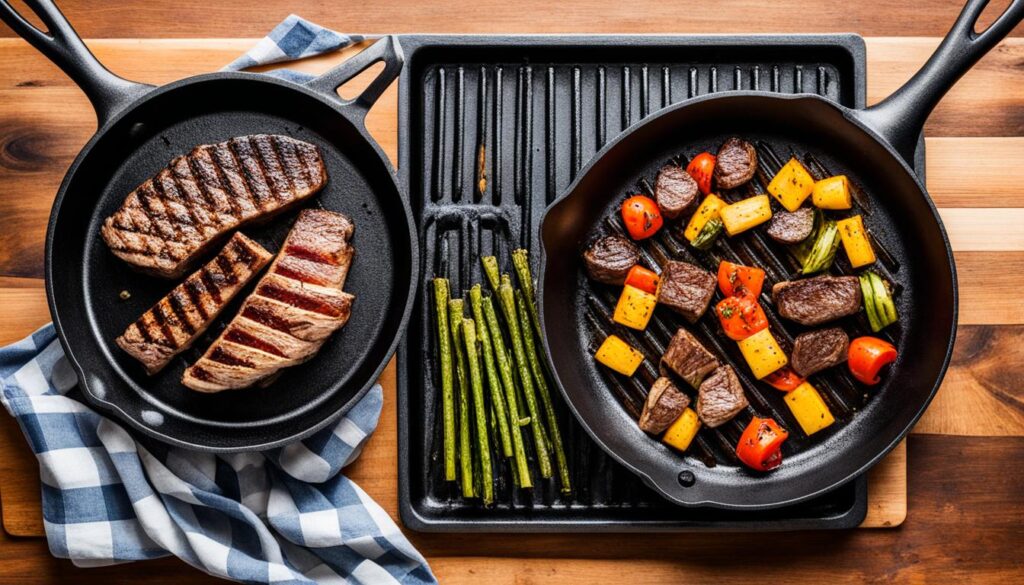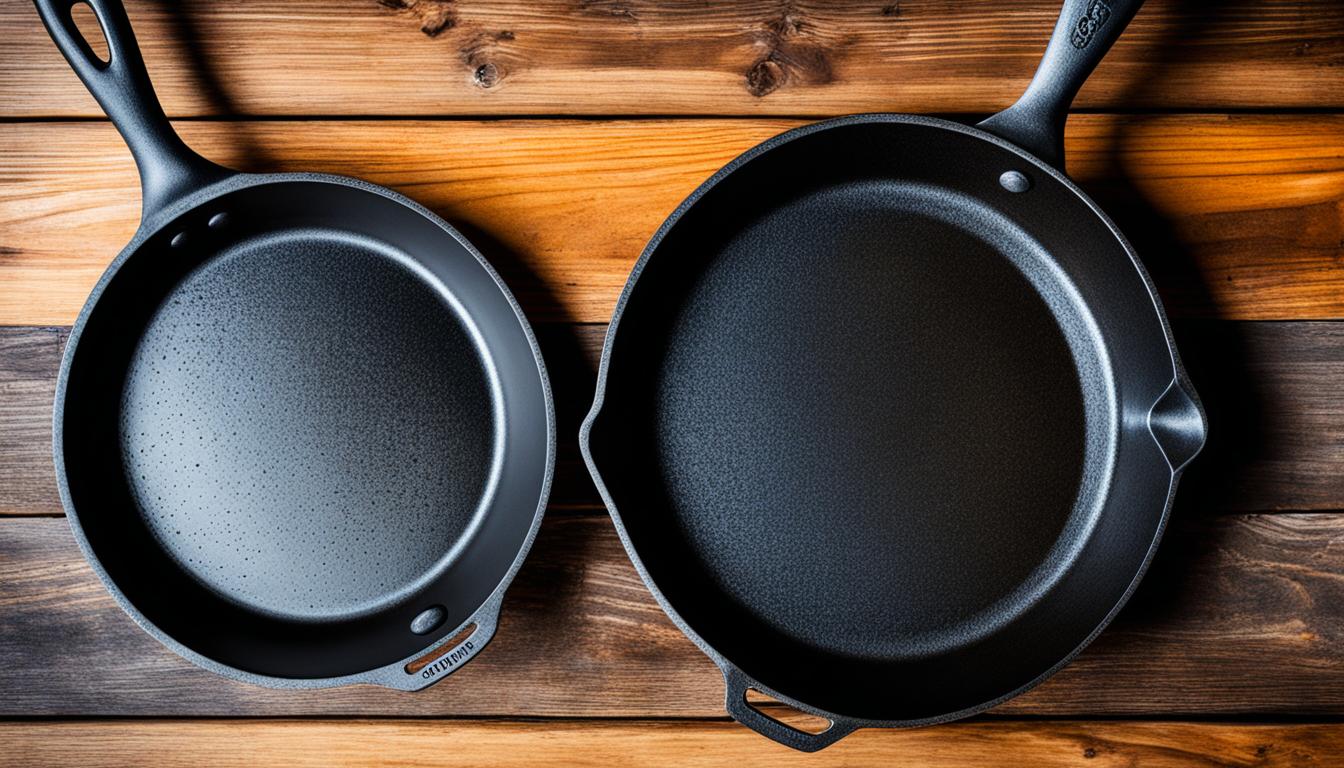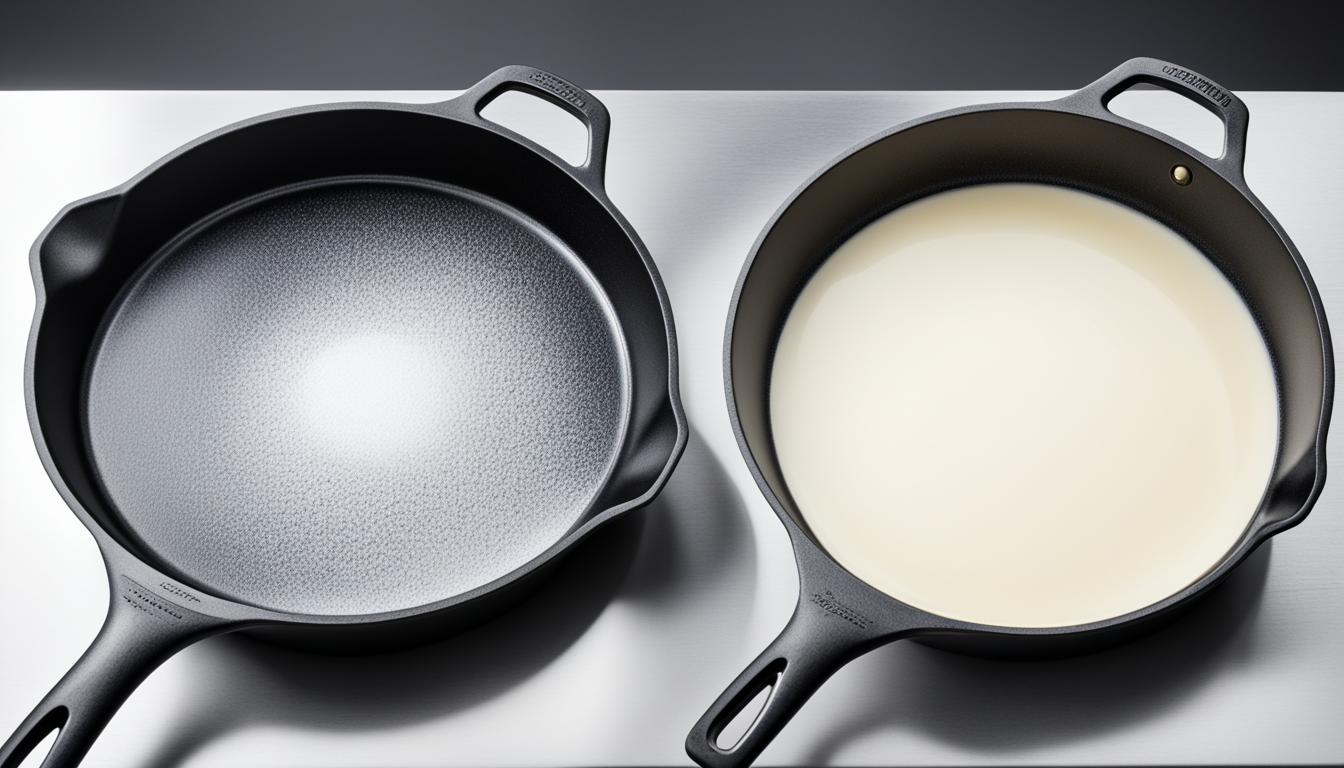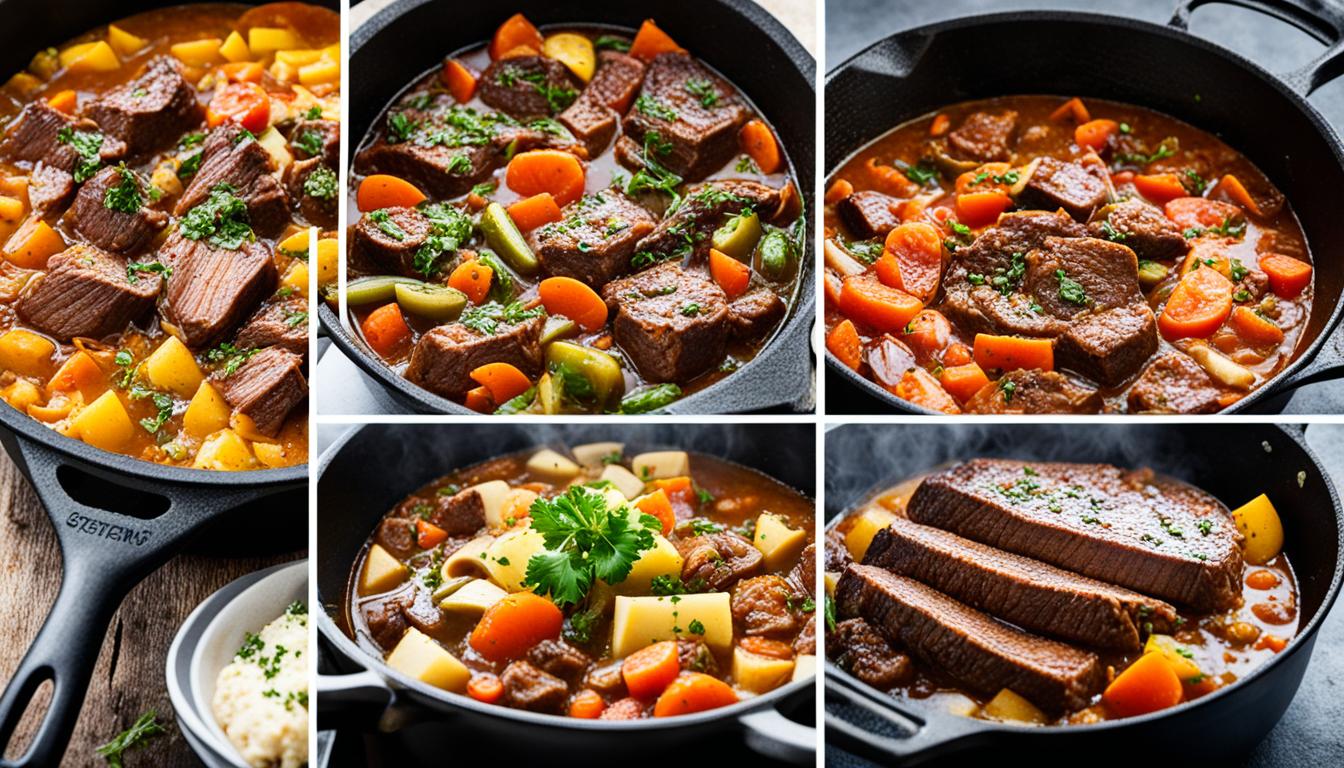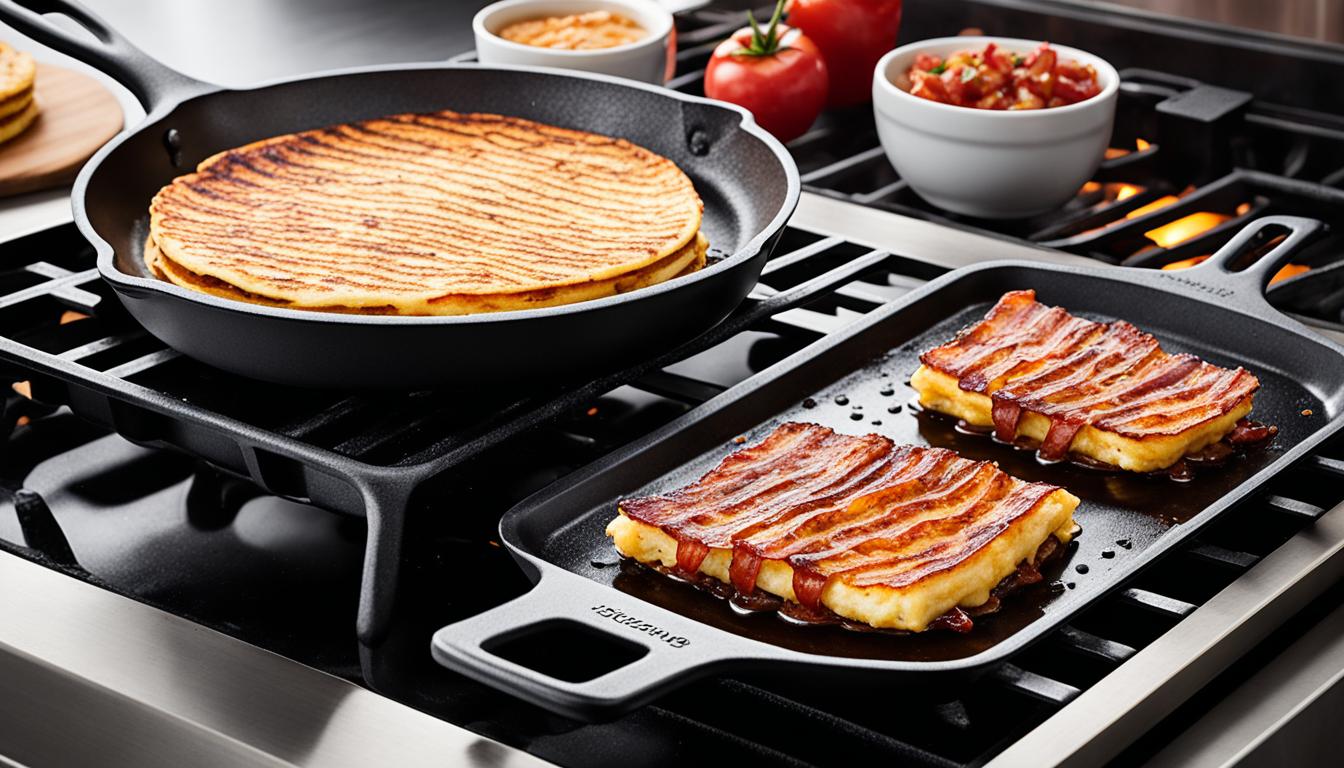Have you ever been stuck between choosing a cast iron skillet and a grill pan? It’s a tough choice. Both are great for cooking. This comparison will show you the unique benefits of each. Let’s look at how they differ.
Cast iron skillets and grill pans are both great for cooking but in different ways. The classic cast iron skillet has a long history in our kitchens. In comparison, the newer grill pan is perfect for getting grill marks without going outside. We’ll look at their features to see which one is best for you.
I’ve used both and found they each excel in different tasks. Whether it’s searing steaks or grilling veggies, both pans are game-changers. We’ll help you pick the best one for your needs. Let’s see who wins in your kitchen essentials.
Key Takeaways
- Cast iron skillets offer superior heat retention and versatility
- Grill pans excel at creating attractive grill marks on food
- Both cooking surfaces require different maintenance routines
- Cast iron can add dietary iron to meals
- Grill pans are typically easier to clean and maintain
- The choice depends on personal cooking style and preferences
Table of Contents
- 1 Introduction to Kitchen Cookware Essentials
- 2 Understanding Cast Iron Skillets
- 3 Exploring Grill Pans
- 4 Heat Retention and Distribution Properties
- 5 Versatility in Cooking Techniques
- 6 Maintenance and Seasoning Requirements
- 7 Health Benefits and Cooking with Less Oil
- 8 Durability and Longevity Comparison
- 9 Aesthetic Appeal and Presentation
- 10 Cost Considerations and Value for Money
- 11 Making the Right Choice for Your Kitchen
Introduction to Kitchen Cookware Essentials
I love exploring kitchen tools as part of my cooking journey. I’ve found that the right cooking surface is key. Today, we’ll talk about the basics of cookware. We’ll focus on two options: cast iron skillets and grill pans.
The Importance of Choosing the Right Cooking Surface
Choosing the right cooking surface is vital for great meals. Each material impacts heat distribution, taste, and nutrition. I look at heat retention, durability, cleaning ease, cooking variety, and health effects when picking my cookware.
Each cooking surface shines in different areas. Cast iron is great at holding heat, giving dishes a tasty sear. In contrast, grill pans make those famous grill marks. Knowing these differences helps me pick the best tool for any given meal.
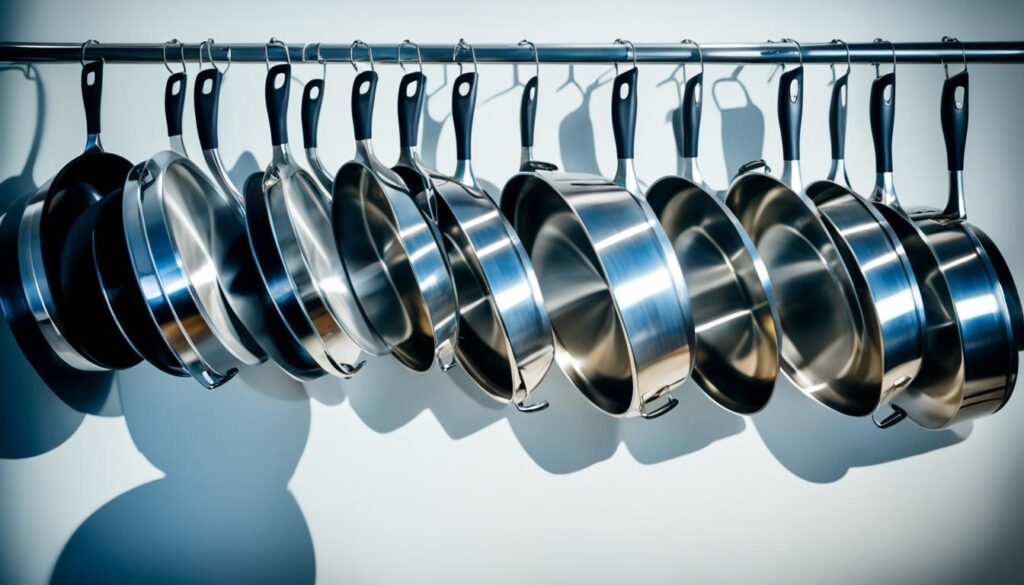
Brief History of Cast Iron and Grill Pans
Cast iron skillets have a rich culinary history. They’ve been used for centuries. Known for their durability and heat retention, they’ve been a kitchen essential globally. On the other hand, grill pans are relatively new. They aim to provide a grill-like experience indoors.
Since 5th century BC, cast iron skillets have evolved into what we use today. Their strength at high temperatures and great heat retention have made them invaluable. Meanwhile, grill pans were introduced in the 20th century. They give stovetop foods grill-like char without going outside. Now, these tools are must-haves for everyone who loves cooking.
| Cookware | Origin | Key Features |
|---|---|---|
| Cast Iron Skillet | 5th century BC | Excellent heat retention, versatility, durability |
| Grill Pan | Mid-20th century | Creates grill marks, indoor grilling option |
Learning about the history and benefits of these tools excites me. It tells me how they fit into cooking today. Understand which pan works best for steaks or veggies improves my dishes.
Understanding Cast Iron Skillets
Cast iron skillets are a must-have for many. They are known for being tough and useful in the kitchen. They cook in a way that other pans just can’t. This makes them loved by both amateurs and professionals.
What Makes Cast Iron Unique
Cast iron’s standout feature is how well it holds heat. This means, even when I add cold food, the pan stays hot. It’s perfect for getting a nice sear on meat or a crispy outer layer on cornbread.
There’s also the special way you care for it, called seasoning. As you use it, the pan naturally becomes slick. I keep mine in top shape by oiling it lightly and putting it in a 350°F oven for an hour. This process makes the pan work better and last longer.
Benefits of Cooking with Cast Iron
Cooking with cast iron has many perks:
- Can be used on stoves, in ovens, or fires.
- With proper upkeep, these pans stay in the family for a long time.
- They add iron to your food.
- Heat spreads evenly, so dishes cook well.
Popular Dishes for Cast Iron Skillets
A cast iron skillet is great for making:
- Skillet cornbread: Brown and moist, just like it should be.
- Seared steaks: They come out just like at fancy steakhouses.
- Deep-dish pizza: Cook a big Chicago-style pizza for your friends.
- One-pot meals: Make anything from paella to jambalaya, all in one place.
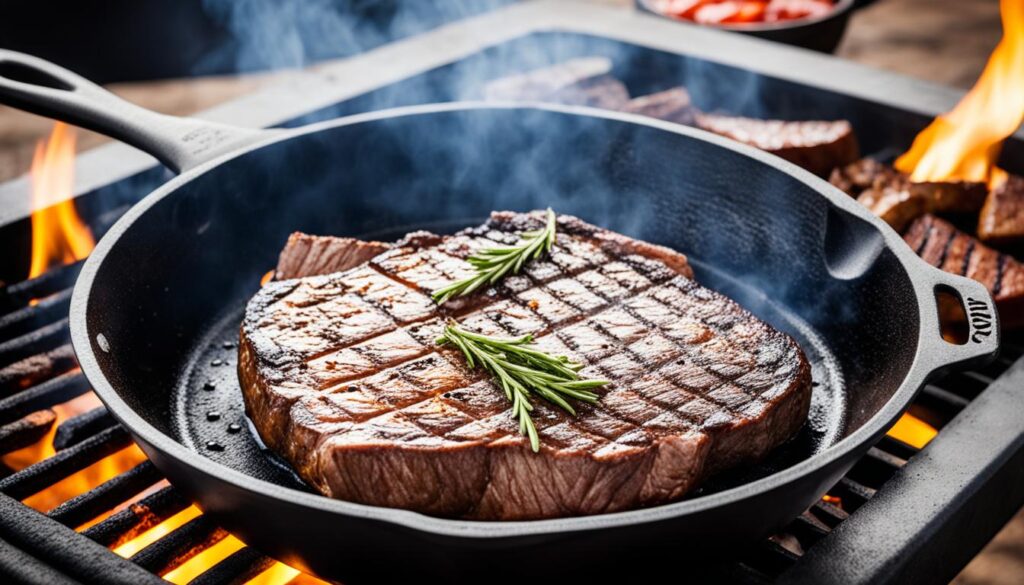
For an authentic Chicago deep-dish pizza, I use 1 pound of shredded mozzarella, 1/2 pound of Italian sausage, and 28 ounces of crushed tomatoes. I bake it at 425°F for 30-35 minutes, creating a mouthwatering meal that showcases the versatility of cast iron cooking.
Exploring Grill Pans
Grill pans are perfect for those who love indoor grilling. They bring the feel of outdoor grilling right into your kitchen. I can make my food look and taste like it’s been grilled outside, all while indoors.
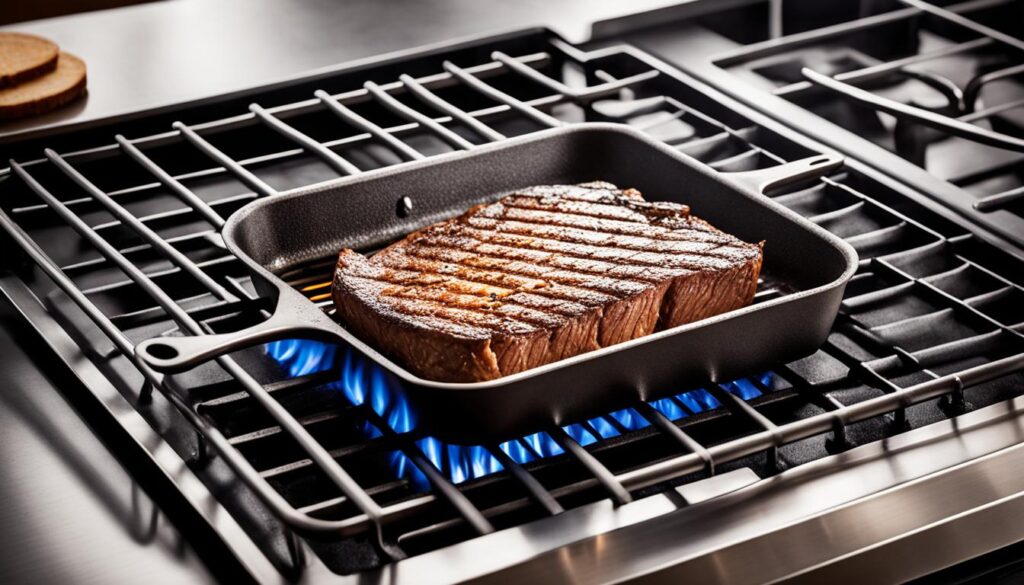
Their ridged design is unique and has many benefits. The ridges help fats drip off the food, making it a healthier way to cook. It’s ideal for dishes like a beef and broccoli stir-fry since you need less cooking oil.
Grill pans are great for cooking different kinds of food:
- Thin slices of meat
- Seafood
- Vegetables
- Sandwiches
Grill pans have many benefits over outdoor grills too:
| Feature | Grill Pan | Outdoor Grill |
|---|---|---|
| Cost | More affordable | Can be expensive |
| Versatility | Use on stovetop or oven | Limited to outdoor use |
| Convenience | Easy to use year-round | Weather-dependent |
| Cleaning | Dishwasher-safe options | Often requires manual cleaning |
I love using grill pans for making quick meals. Like a beef and broccoli stir-fry that’s ready in 25 minutes, great for busy nights. The ridges not only make food look appetizing but also help in draining fat for healthier dishes. Each serving has just 327 calories.
When using a grill pan, cook beef for about 2-3 minutes until brown. Then, add the broccoli for another 2-3 minutes. This way, the meat is juicy and the veggies stay crisp. The ridges create beautiful grill marks that make the dish look great.
Heat Retention and Distribution Properties
Cooking with cast iron skillets and grill pans is a joy. They keep heat well and spread it evenly. This means you get even cooking and the best results. Now, let’s talk about how these features make your meals better.
Cast iron skillets hold heat like a boss. They stay hot, great for cooking dishes that need a steady heat. They’re the top choice for searing meats or making a tasty Chinese Chicken Cabbage Stir Fry.
Grill pans, however, are masters at spreading heat. Their ridges make those awesome grill marks. Plus, they let extra fat drip away, making meals both quicker and healthier.
Impact on Cooking Techniques
These pan’s heat properties change how you cook:
- Searing: Cast iron’s high heat retention excels at creating a perfect crust on steaks.
- Stir-frying: Grill pans’ quick heat response is ideal for fast, high-heat cooking.
- Braising: Cast iron’s even heat distribution ensures tender, slow-cooked dishes.
- Grilling: Grill pans’ ridges mimic outdoor grilling, perfect for vegetables and meats.
Controlling temperature is vital with these pans. Cast iron warms up slowly but keeps hot longer. Grill pans quickly adjust to temperature shifts. Knowing these basics helps you cook better.
| Property | Cast Iron Skillet | Grill Pan |
|---|---|---|
| Heat Retention | Excellent | Good |
| Heat Distribution | Even | Concentrated on ridges |
| Cooking Speed | Slower, steady | Faster, variable |
| Best For | Searing, braising | Grilling, stir-frying |
Learning to use these pans’ heat traits well can upgrade your cooking. You’ll make meals that taste like they’re from a top-notch restaurant.
Versatility in Cooking Techniques
Cast iron skillets and grill pans boost your kitchen game with special cooking skills. Knowing how to use them right makes cooking more fun. They give your food unique tastes and textures.
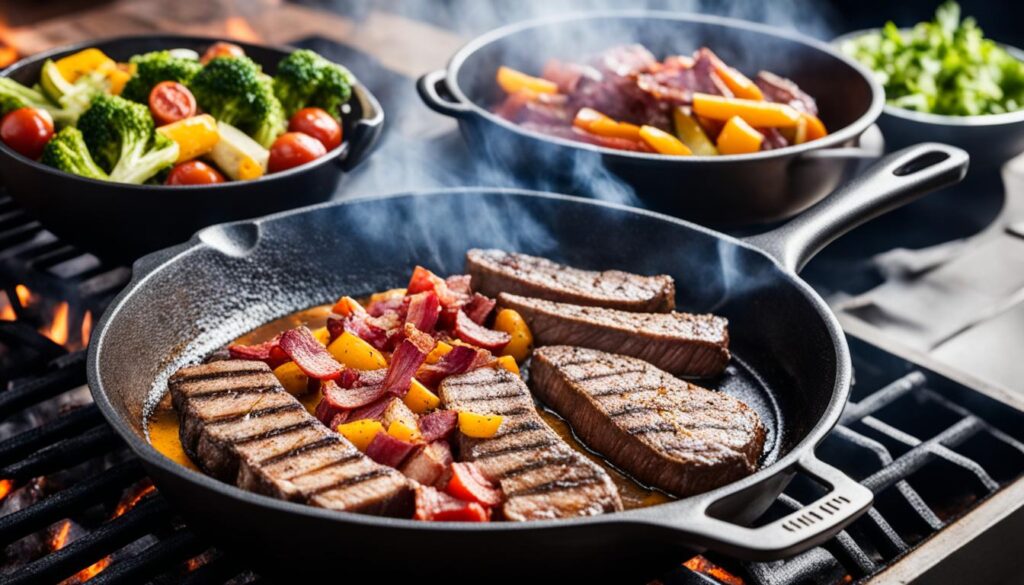
Searing and Browning Capabilities
Cast iron skillets are boss at searing and browning. They keep heat well, making a tasty crust on food. Want to get your food just right? Follow these steps:
- Preheat the skillet over medium-high heat for 5 minutes
- Add 1 tablespoon of oil with a high smoke point (like avocado oil)
- Place the seasoned meat or vegetables in the pan
- Cook without moving for 3-4 minutes to develop a crust
- Flip and repeat on the other side
Grilling and Creating Grill Marks
For indoor grilling, grill pans are champions. They leave those grill marks that look so good. Don’t forget, perfect grill marks need this strategy:
- Preheat the grill pan over medium-high heat
- Lightly brush the food with oil to prevent sticking
- Place the food at a 45-degree angle to the ridges
- Cook for 2-3 minutes, then rotate 90 degrees for crosshatch marks
- Flip and repeat on the other side
Baking and Oven Use
Cast iron skillets are not just for stovetop cooking. They’re great for baking, giving foods a nice, even crust. For baking, here’s how I do it:
- Preheat the oven to the recipe’s specified temperature
- Grease the skillet with butter or oil
- Pour in the batter or arrange the ingredients
- Bake according to the recipe, usually 20-30 minutes for most dishes
Grill pans can also help with baking, especially for dishes that need a crunchy base. They bring a cool look and feel to the food.
| Cooking Technique | Cast Iron Skillet | Grill Pan |
|---|---|---|
| Searing | Excellent | Good |
| Grilling | Good | Excellent |
| Baking | Excellent | Limited |
| Versatility | High | Moderate |
Both cast iron skillets and grill pans have their special uses. What you pick depends on how you like to cook and what dishes you love. They really bring a lot to the kitchen.
Maintenance and Seasoning Requirements
Taking care of your cast iron skillet or grill pan is highly important. I will show you how to properly care for them. This includes the seasoning process and how to clean them.
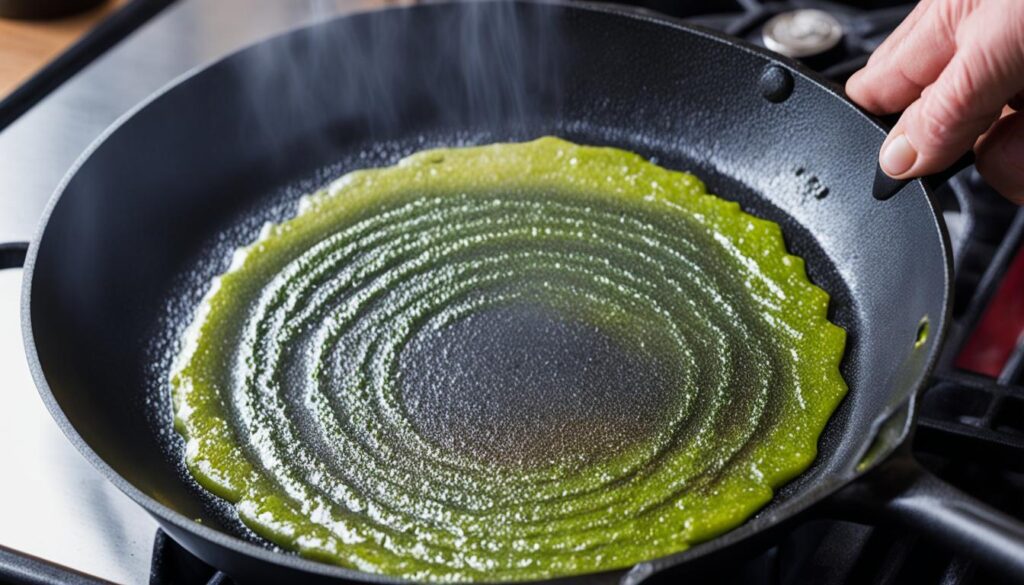
Cast iron skillets need a certain way to be seasoned. Seasoning makes them non-stick and stops rust. To season your skillet:
- Scrub the pan with kosher salt to remove any residue
- Apply a thin layer of unsaturated fat, like vegetable oil
- Heat the pan in a 450°F oven for 30 minutes
- Repeat this process 3-4 times for optimal results
The more you cook with a seasoned skillet, the better it gets. After a few weeks, it’s non-stick enough for eggs not to stick. Grill pans are easier; you don’t need to season them as much.
When cleaning cast iron, be careful. Don’t use dish soap because it can damage the seasoning. Here’s how to clean it:
- Scrape off food bits with a spatula or brush
- Rinse with hot water
- Dry promptly to prevent rust
- Apply a light coat of oil
Grill pans are simpler to clean. You can use a bit of soap and water. Just be sure to fully dry them afterwards.
| Cookware | Seasoning Requirement | Cleaning Method |
|---|---|---|
| Cast Iron Skillet | Regular seasoning needed | No soap, scrape and oil |
| Grill Pan | Minimal to none | Mild soap and water |
Keep in mind, caring for your cookware makes it last longer. These tips will help you enjoy your pans for many years.
Health Benefits and Cooking with Less Oil
I always look for ways to make my food both tasty and healthy. Cast iron skillets and grill pans are great for this. They give us a chance to eat better by cooking in a certain way.
Iron Fortification from Cast Iron Cooking
Cast iron skillets add more than flavor to our meals – they add iron. When I cook acidic foods in them, the food gets a tiny bit of iron. This is great for people who need more iron in their diet.

Low-Fat Cooking with Grill Pans
I use grill pans a lot for healthy indoor grilling. The ridges let the extra fat drain off. This means my dishes are healthier and don’t need as much oil.
Let’s see how these cooking tools can make a healthy recipe even better.
| Recipe: Shrimp and Broccoli Stir Fry | Nutritional Info | Cooking Method Benefits |
|---|---|---|
| Total Time: 30 minutes (25 min prep) | Serves: 4 | Cast Iron: Cooks food evenly |
| Calories per serving: 327 | Protein in shrimp: 12g per 3 oz | Grill Pan: Uses less oil |
| Broccoli: Full of fiber, vitamins C & K | Healthy, balanced meal | Both: Encourage healthy cooking |
This shrimp and broccoli stir fry shows how cooking tools make meals healthier. Using a cast iron skillet or a grill pan improves our cooking habits. These tools are good for our health and our food.
Durability and Longevity Comparison
When considering a kitchen investment, durability is key. Cast iron skillets and grill pans vary in their lifespan. This affects their value as durable tools.
Cast iron skillets are known for being extremely durable. They can still work perfectly after many decades. Their strong build and the ability to handle high heat make them tough to break.
Grill pans are also tough but may not last as long as cast iron. The ridges that give them their special grilling marks can wear out over time. This wears out faster with lots of use and scrubbing.
Let’s compare these two popular kitchen items:
| Feature | Cast Iron Skillet | Grill Pan |
|---|---|---|
| Average Lifespan | 50+ years | 10-15 years |
| Wear Resistance | Extremely high | Moderate to high |
| Heat Tolerance | Very high | High |
| Maintenance Needs | Regular seasoning | Standard cleaning |
Cast iron skillets often provide better long-term value. They can last for many decades, becoming family treasures. Grill pans, although not lasting as long, still offer great value.
For someone wanting long-lasting items in the kitchen, both choices are good. The best pick depends on what you cook and how much effort you want to put into care.
- Cast iron skillets: Great for those who want something that lasts and is versatile
- Grill pans: Perfect for those who like indoor grilling and don’t mind replacing items sooner
Taking good care of your cookware can make them last longer. This way, you get more value from your kitchen gear.
Aesthetic Appeal and Presentation
Cast iron skillets and grill pans add something special to food. They make dishes look better, making meals more exciting. These cooking tools are key in making food look great.
Grill Marks and Visual Appeal
Grill pans give food those nice grill marks. It makes your meal look like it was made by a pro. Not only do these lines look good, they also make the food taste better.
- Creates attractive crosshatch patterns on meats and vegetables
- Enhances visual appeal of grilled foods
- Adds a professional touch to home-cooked meals
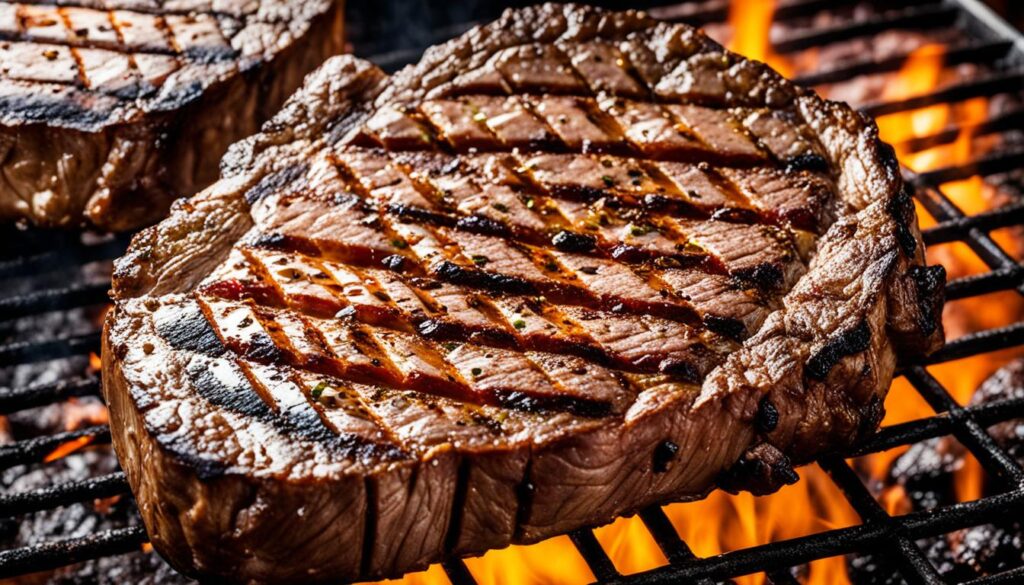
Rustic Charm of Cast Iron
Cast iron skillets add a classic, rustic feel to meals. The dark color of these pans makes dishes stand out. It moves easily from cooking to serving, making meals look true to life.
Comparing grill pans to cast iron skillets shows their different looks.
| Feature | Grill Pan | Cast Iron Skillet |
|---|---|---|
| Visual Signature | Grill marks | Rustic patina |
| Plating Style | Modern, precise | Homestyle, rustic |
| Table Presentation | Individual servings | Family-style dishes |
| Color Contrast | High contrast with light foods | Rich backdrop for vibrant ingredients |
Both types of cookware offer fun ways to present food. They help achieve various styles, whether modern or traditional. I use these tools to make my dishes look amazing. This impresses friends and family with beautiful meals.
Cost Considerations and Value for Money
Cast iron skillets and grill pans vary in price, but both can be great choices for your kitchen. They stay among the top picks for a reason. Let’s dive into this topic and find the best bang for your buck.
The cost of cast iron skillets can differ a lot. The Lodge Cast-Iron Skillet is a favorite for people just starting or on a tight budget. It cooks great without breaking the bank. Then, there’s the Field Company’s No. 8 Skillet. It’s lighter and fancier, but costs more.
Grill pans, too, come in a wide price range. Let’s look at some well-known choices:
| Grill Pan | Weight | Dimensions | Price Range |
|---|---|---|---|
| Le Creuset Signature Enameled Cast Iron | 7 lbs | 13.9 x 15.1 x 2.6 inches | High |
| Lodge Pre-Seasoned Cast Iron | 6.5 lbs | 17.25 x 10.5 x 2.62 inches | Low to Medium |
| Gotham Steel Aluminum | 1.8 lbs | 18.11 x 10.63 x 1.5 inches | Low |
Before you buy, think about:
- Cast iron cookware lasts a long time with care
- Nonstick skillets might need replacing every few years
- Cast iron can handle high heat and is great for browning
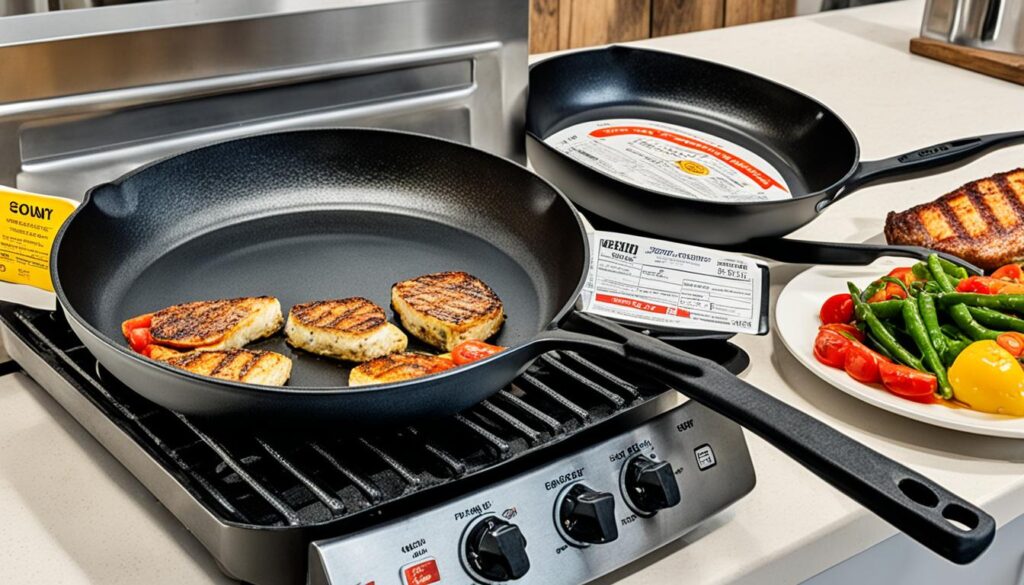
Quality cast iron costs more upfront, but it lasts and does more. Grill pans, on the other hand, are all about grilling indoors. They can fit anyone’s budget. Pick what fits your kitchen and future cooking plans best.
Making the Right Choice for Your Kitchen
Choosing between cast iron skillets and grill pans is key for your kitchen. Cast iron skillets last up to 12 years and are great for even heat and flavor. They are perfect for quickly searing steaks to perfection.
Grill pans offer a different cooking experience. They’re made of stainless steel, which heats up slowly but keeps food warm. You can get those classic grill marks, with ideal grates 0.2 inches apart. What’s more, stainless steel grill pans are easy to clean in the dishwasher and don’t rust easily.
Your decision relies on your cooking preferences. If you like to season your cookware and want durability, choose a cast iron skillet. It’s also good for use in the oven and on induction cooktops. For those who prefer lighter pans and simple cleaning, a stainless steel grill pan might be better. The important thing is to pick what suits your cooking style and kitchen best.
